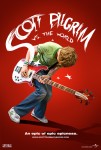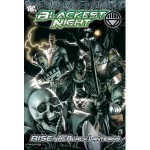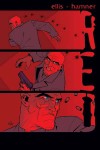Comics to Film: Who Boosts Whom?
 There’s been a clear trend over the past few weeks on the NYT Graphic Books Best Seller list. Blackest Night, the Green Lantern storyline extravaganza, and Scott Pilgrim, the film arriving to rock your geek movie world, dominate the lists. Siege, a title clearly aimed at reintroducing and reinvigorating the Avengers comics, ranks well, heralding good news for the still years-away Avengers movie (currently scheduled for 2012).
There’s been a clear trend over the past few weeks on the NYT Graphic Books Best Seller list. Blackest Night, the Green Lantern storyline extravaganza, and Scott Pilgrim, the film arriving to rock your geek movie world, dominate the lists. Siege, a title clearly aimed at reintroducing and reinvigorating the Avengers comics, ranks well, heralding good news for the still years-away Avengers movie (currently scheduled for 2012).
The just-wrapped San Diego Comic-Con was awash in new announcements for films based on comics, demonstrating once again the power of geek fandom as well as the ease with which Hollywood gobbles up potential source material.
All of this leads me to ask a question I’ve long wondered about in this era of Hollywood rehashing comics; how much good does media exposure, via films or TV, do for a comic book series or graphic novel?
It’s clear that interest spikes around a film’s release. Watchmen, the graphic novel, certainly sold more during the build up to the film’s release, but it continues to sit pretty on the Best Seller list, having stayed there for 74 weeks. Watchmen was a consistently popular title before the film, and it continues to be a popular title after. The bump in film popularity may have helped to introduce more people to the book, but how much did it need the help and did that translate into an appreciation of the format beyond Watchmen itself?
 Scott Pilgrim, as a comic book series, has long been beloved by its devoted fans. Creator Bryan Lee O’Malley and Oni Press have reaped great rewards from the upcoming film’s buzz (poster at left), as well as the fact that the final volume’s release so nearly coincided with the film’s release this Friday.
Scott Pilgrim, as a comic book series, has long been beloved by its devoted fans. Creator Bryan Lee O’Malley and Oni Press have reaped great rewards from the upcoming film’s buzz (poster at left), as well as the fact that the final volume’s release so nearly coincided with the film’s release this Friday.
Both of the previous titles are no-brainers. The comics were the direct source for the films, so if people walk in off the street wanting the origin of the movie they’ve just seen, you can hand them the books without qualms.
 What about Green Lantern, coming out next June? The Blackest Night volumes are racing up the charts and holding steady. The film is highly anticipated, as indicated by Entertainment Weekly’s cover featuring it nearly a year before the movie’s release. It was also promoted at Comic-Con this year, where star Ryan Reynolds charmed everyone by reciting the entire Green Lantern oath for a young fan.
What about Green Lantern, coming out next June? The Blackest Night volumes are racing up the charts and holding steady. The film is highly anticipated, as indicated by Entertainment Weekly’s cover featuring it nearly a year before the movie’s release. It was also promoted at Comic-Con this year, where star Ryan Reynolds charmed everyone by reciting the entire Green Lantern oath for a young fan.
However, those intrigued by the Green Lantern movie are unlikely to be engaged by the continuity-heavy, you-must-buy-every-single-collection tale like Blackest Night. The folks buying Blackest Night? They are already Green Lantern comics fans. People haven’t been tearing into my library to get the skinny on Green Lantern, at least not yet, and I’m wondering if and how much they will. In chatting with patrons, it’s clear they know Batman, The X-Men, Wolverine, and Spider-Man from the movies and pop culture osmosis. The bulk of them are not interested in reading the comics related to the franchise; they’re happy to wait for the next movie.
The most viable titles for a library to collect are those that have a direct connection to the film or TV series, either as the direct origin or a strong inspiration for the style or voice, not comics that simply feature the same characters.
When Batman Begins and The Dark Knight were carrying away box office millions, it was easy to locate and hand out the inspirations: Frank Miller’s Batman: Year One, Grant Morrison’s Batman: Arkham Asylum, Alan Moore’s Batman: The Killing Joke, and Brian Azzarello’s Joker. Fans of the campy Batman TV show may have been startled, but the grim view of the Batman movie reboot had been flavoring Batman comics for decades. Similarly, The Walking Dead, the much-buzzed about AMC TV adaptation of the now complete Robert Kirkman series, beginning in October, is already leading folks to the source material.
Librarians need to know which titles are worth our investment. Ed Brubaker’s strong run on Captain America and Robert Kirkman’s The Walking Dead are both quality and popular, and thus very much worth any library’s dollars. But I have yet to hear of a significant Thor volume I must purchase from either fans or reviews. The 2011 movies Thor and Captain America: The First Avenger, as well as 2012’s The Avengers will need clear, continuity-free volumes to have an significant affect on the comics’ popularity with readers.
 For lesser known titles, the impact remains to be seen. In previous years, my library patrons requested Mark Millar’s Wanted from the film of the same name, although readers were disappointed that the film had little to do with the comic — the film rights were purchased even before the comic had been finished. The graphic novel Wanted seems to go out now because it’s a Mark Millar title, not because it’s related to the lackluster film.
For lesser known titles, the impact remains to be seen. In previous years, my library patrons requested Mark Millar’s Wanted from the film of the same name, although readers were disappointed that the film had little to do with the comic — the film rights were purchased even before the comic had been finished. The graphic novel Wanted seems to go out now because it’s a Mark Millar title, not because it’s related to the lackluster film.
At Comic-Con, Bruce Willis and Helen Mirren were on hand to trumpet the upcoming film adaptation of Warren Ellis’s little-known Red, coming in October. The casual Bruce Willis or Helen Mirren fan may not realize the film is based on a limited series comic book. I will be waiting to see if sales and requests for the single-volume graphic novel start to rise.
So my question to you, dear reader, is what comics titles are getting demand due to films and TV? Which have proven worth keeping in your collection? I’ll be tracking this year’s upcoming tie-ins, and will report back on how much impact media attention has on graphic novels and comics beyond the first big bump.


August 12th, 2010 at 11:33 am
[…] Comments RSS « Comics to Film: Who Boosts Whom? […]